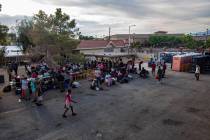Colorado River, Lake Mead all wet
Just when you think you can count on predictable weather, a storm rolls in and changes your plans.
That certainly was the case for plenty of Mother's Day outings in Las Vegas. High winds tend to ruin spring strolls, picnics and patio dining.
It's also true for the region's water managers. But in their case, it's great news.
A decade of drought along the Colorado River has forced officials to bank on below-average runoff from the mountains that feed the system. Last fall, climate experts said a strong La Nina pattern would dry out winter and spring, limiting the snowfall that, after melting, turns into most of the Southwest's drinking water supplies. That forecast was expected to worsen an extended shortage, forcing Nevada and Arizona officials to make preparations for a crisis declaration that would reduce their annual river allotments -- perhaps as soon as this year.
Instead, the skies dumped snow for months on end in just the right spots. It's still snowing, in fact.
Every month, the U.S. Bureau of Reclamation has been increasing its river flow projections. The latest estimates have the Colorado awash with 11.5 million acre-feet of water between April and July, 45 percent more than the average flow over the past century. That will result in the largest release of water into Lake Mead since 1998, enough to lift its level roughly 30 feet by next February. And the numbers could get even better.
"As of (last) Monday, we still hadn't reached the peak of the snowpack. It just keeps growing," Terry Fulp, deputy director for the bureau's Lower Colorado region, told the Review-Journal. "It's been remarkable."
That means the shortage declaration that would have triggered severe water-use restrictions in Southern Nevada, deemed imminent only several months ago, likely won't take effect for several years -- even if future river flows return to drought levels. Considering the lingering misery from the valley's housing and unemployment woes, it's wonderful to know that water supplies won't hurt our economic recovery in the short term.
Of course, this doesn't change the reality of the valley's long-term water needs. The conservation initiatives that have stretched our Colorado River allotment over the years -- allowing us to use less and less water each year despite population growth -- must continue. And the development of additional supplies as insurance against continued drought on the Colorado must continue.
Mother Nature has given us a reprieve. But she remains as mercurial as ever.

















